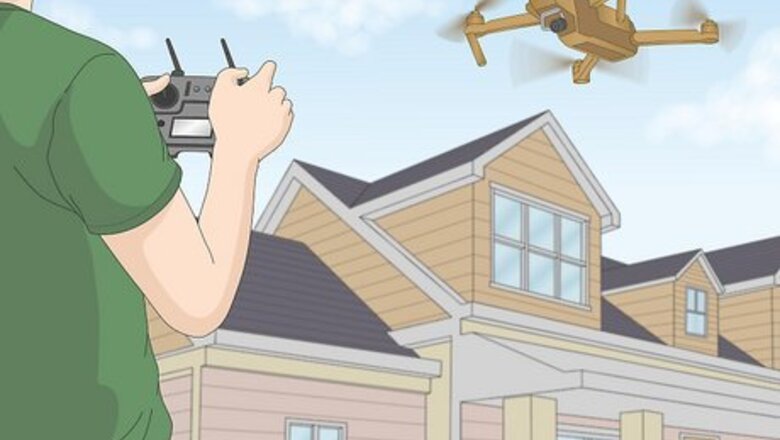
views
- It’s legal for a drone to fly over your home so long as the pilot obeys the Federal Aviation Administration’s rules for Unmanned Aircraft Systems.
- If the drone breaks the rules (ex: flying at night, above 400 feet (120 m), or over 100 miles (160 km) per hour) report it to the FAA.
- Find the drone pilot and ask them to stop flying the drone over your home. Also, post signs on your property requesting that people don’t fly drones in the area.
- It’s illegal for you to forcibly remove the drone from the area above your property by shooting it down or using a net, signal jammer, or any other method.
Is it legal for a drone to fly over my house?
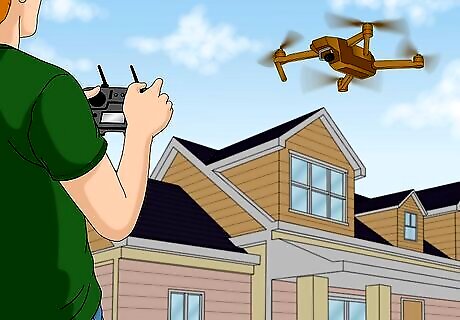
Yes, it’s legal but there are some limitations. Drones are allowed to fly during daylight in uncontrolled airspace below 400 feet (120 m). They must not exceed a speed of 100 miles (160 km) per hour. The Federal Aviation Administration (FAA) has exclusive regulation over all navigable airspace, meaning that, so long as the drones are abiding by the rules for either recreational or commercial use, it’s legal for them to fly over your home. If a drone is flying over your property and taking pictures and videos of you without your consent, then it is violating the FAA’s privacy guidelines. However, you would need to be able to provide evidence that a drone is taking footage of you in order to prove that it has violated the FAA guidelines, and this is incredibly difficult to obtain. There are some restrictions about where drones can fly, including stadiums and sporting events, airports, government-secured airspaces, and the greater Washington, D.C. area.
Can I remove a drone from the airspace above my property?
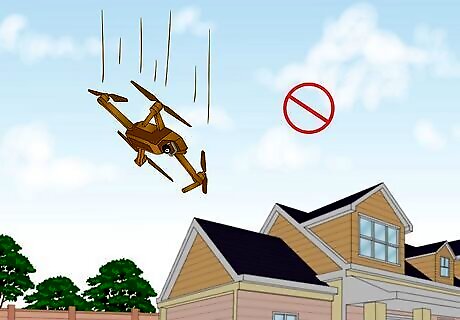
Unfortunately, it’s currently illegal to take down a drone flying above your property. Because drones are privately-owned property flying in government-regulated airspace, they are federally protected from criminal destruction of all forms, even if they are flying above your home. Interfering with drones that are following FAA rules and regulations by shooting them down or by any other method carries a penalty of up to 20 years in prison. Not only is it illegal to remove a drone from FAA-regulated airspace, but you may be responsible for paying for any damages done to the UAS in any attempt to remove it wilfully. If the drone is operated in a reckless or careless manner or causes injury to property or a person, contact local law enforcement.
Legal Ways to Stop a Drone from Flying Over Your House
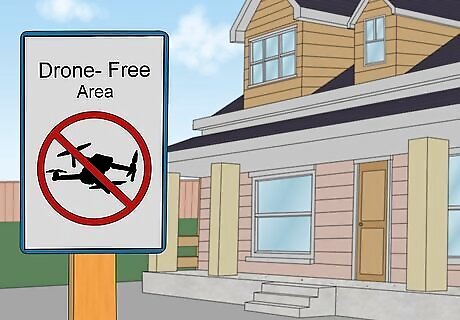
Use signs to mark your property as a drone-free area. You can make or order your own signs that indicate you don’t want drones to fly in the airspace above your property. Hopefully, drone pilots will see and heed your warning signs. When making or ordering signs be careful not to claim that your property is a “no drone zone” as that is inaccurate to the FAA UAS regulations. You can be reported and asked to remove the signage.

File a complaint with the FAA if the drone pilot breaks the law. You can report a drone that is breaking FAA rules and regulations by contacting your local Flight Standards District Office. Find your local office here: https://www.faa.gov/about/office_org/field_offices/fsdo/ It’s not enough to simply be bothered by a drone over your property to file a complaint; the operator must be violating the laws in some way, such as landing on your property or flying above 400 feet (120 m), as outlined by the FAA.
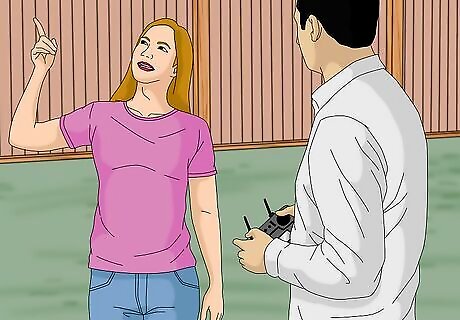
Ask the drone pilot to stop flying over your property. Many hobbyist and amateur drone pilots may not realize that their drone use is upsetting you. Because drone pilots have to be within sight distance of their drone, you should be able to spot them in the area. Politely request that the person does not fly the drone over your property. Unfortunately, a drone pilot does not legally have to comply with your request. Asking nicely definitely increases your chances that they’ll be persuaded to avoid your property in the future, though!

Lobby for legislation that restricts the use of drones. There are many people with concerns about privacy when it comes to drones. Contact members of Congress or House Representatives and ask them to support bills that restrict the use of drones above private property. Or, reach out to a special interest group that lobbies against drone usage.
Illegal Methods for Disabling Drones
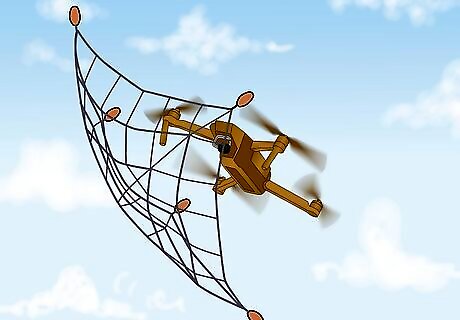
Nets The Department of Defense disables unauthorized drones in restricted flight areas by using other UAS that are outfitted with nets. This allows them to remove drones from prohibited airspaces without destroying the machinery, making it easier to trace where the drone came from. Civilians are not allowed to use nets or any other method to disable a drone.
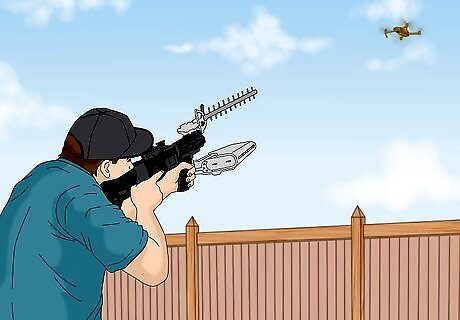
Signal jamming The method of signal jamming uses electromagnetic signals to override the drone’s communications system, which triggers it to return to the pilot. Signal jamming techniques have been developed for the U.S. Special Forces and other individuals authorized by the federal government. Unauthorized individuals who use signal jamming to interfere with legal drone piloting are criminally liable.
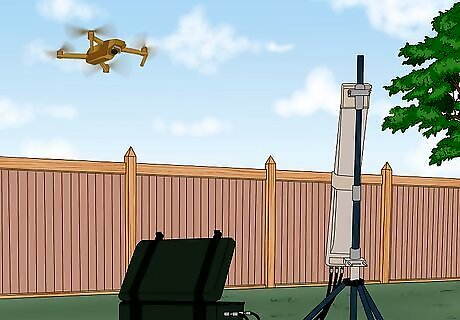
Signal spoofing A cousin of signal jamming, spoofing is a method of hijacking a drone by tapping into the machine’s unencrypted GPS signals and making it fly elsewhere. While this is used by military intelligence to hack unauthorized drones, it is illegal for private residents to use.
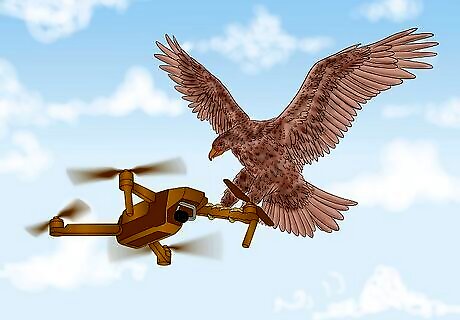
Birds of prey Some countries, such as the United Kingdom, France, and the Netherlands, have tried training eagles to snap unauthorized drones out of the sky. As birds of prey hunt for a living, they’re experts at grabbing smaller drones midair, but the method raises questions about animal safety. Do not try this at home.
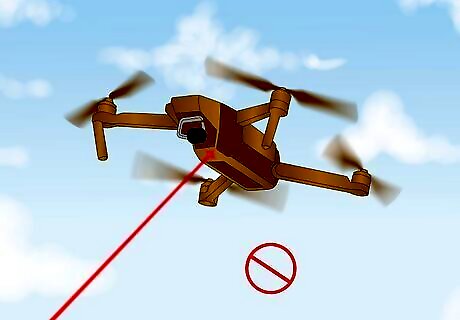
Lasers It is possible to destroy or damage a drone with a high-powered laser. Not only is it illegal to interfere with authorized drone flying, but it is also a federal crime to point a laser at an aircraft, as it might blind the pilot.
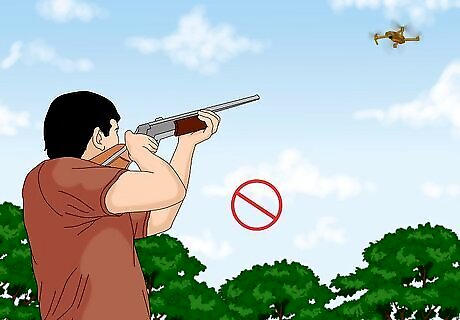
Bullets While there have been reports of people shooting drones out of the sky, it is incredibly dangerous and illegal in many ways. Never fire a weapon at a drone or any other aircraft. Not only will you be forced to pay for the damages to the drone and likely be criminally charged for interfering with legal drone piloting, but it’s also possible to be charged with reckless endangerment.



















Comments
0 comment